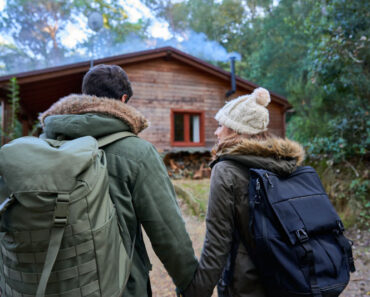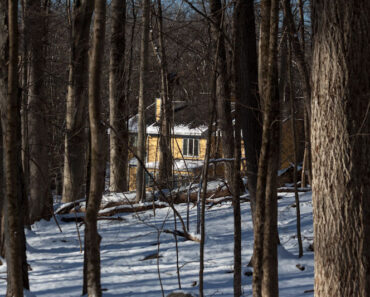When facing a SHTF event, preppers fall into two categories: those who prefer to fortify their homes and stay put (bugging in) and those who choose to hit the road and evacuate before chaos ensues (bugging out).
Both strategies come with their own set of advantages and disadvantages. It is crucial to assess what suits you and your circumstances based on factors such as geographical location, population density, skills, and available resources.
For newcomers to prepping, bugging in often appears as the most prudent course of action, as it eliminates the immediate concerns of finding shelter and food—two essentials that can be challenging to secure in a disaster-stricken area. Additionally, if you have young children or elderly family members, bugging in may be the optimal choice for ensuring their safety and well-being.
Bugging in provides the benefit of remaining in familiar surroundings and maintaining access to all your supplies. However, it also entails the risk of being confined to an unsafe or challenging-to-escape area. For those residing in urban areas, bugging in might not be a viable option during widespread civil unrest or if the neighborhood becomes unsafe.
If you opt to stay and defend your home, here are some tips for preparing to bug in, ensuring you are as well-prepared as possible should the need arise.
Get everyone home
At the initial signs of danger, it is imperative to ensure that everyone promptly heads home, doing so with utmost speed.
The foremost priority is to assess the situation and determine if there is a viable means of reaching home through personal transportation. If not, the next best course of action is to seek out someone who can provide a ride, whether it be a friend or, if necessary, a stranger. Once a ride is secured, it is crucial to have a well-thought-out plan detailing the destination and the route to be taken.
If driving proves unfeasible, the next viable option is public transportation. This necessitates careful planning on your part, familiarizing yourself with available routes, and estimating the travel time to your destination. In certain scenarios, public transportation may even prove to be a faster alternative to driving. Additionally, exploring alternative modes of transportation, such as electric bikes or scooters, is advisable, given their extended range on a single charge.
Communicate with those who haven’t made it to safety
It’s highly probable that individuals and their loved ones won’t be at home when a crisis occurs. In such situations, it is essential to establish designated meeting points at various locations within your living area. Planning for multiple meeting points becomes necessary, and these should be determined after mapping out everyone’s regular routes for work, school, shopping, etc.
Once individuals gather at the designated meeting points, a thorough assessment of the situation is crucial. Determine whether it is more feasible for you to reach them or if they can safely make their way home independently. Depending on the circumstances, it might be necessary to undertake multiple trips to gather everyone, and it could be beneficial for all parties to convene at a single, safe meeting point. This approach ensures that, even if you have to take a lengthy detour, the assurance remains that they will be in a secure location upon your arrival.
Gather as much information as possible about the emergency
It is imperative to stay vigilant by consistently monitoring news updates and local broadcasts within the initial 24 to 48 hours. In the event that you are unable to fulfill this responsibility, it is advisable for your spouse to take charge of this task. Staying well-informed not only aids in planning extraction routes to bring everyone home but also facilitates identifying and avoiding potential hot zones.
Remaining well-informed is essential, as it enables you to make informed decisions about whether it’s necessary to expedite everyone’s return home and fortify your residence, especially if bugging out is not a viable option, particularly in areas identified as hot zones.
Make a last-minute shopping trip
Certain individuals may have the privilege of embarking on a last-minute shopping trip to acquire additional supplies, even if they have already stockpiled essentials at home. This may involve obtaining extra food, water, or fuel. However, it is crucial to ensure that the chosen store or gas station is not situated in a hot zone susceptible to looting. Moreover, one should have the means to swiftly purchase the necessary items before lines begin to form.
Maintaining a reserve of cash is paramount during emergencies. Reliance on credit cards or payment apps may prove unreliable. It is advisable to cultivate a habit of keeping $1000 readily available and distributed in various denominations.
In the event of purchasing a substantial quantity of items, it is important to consider concealing them effectively. If, for instance, you acquire boxes of food or multiple jerrycans for your truck, covering them with a tarp ensures discretion and allows you to proceed without drawing unnecessary attention.
Secure the home
Securing one’s residence in the United States should be standard practice, regardless of whether you reside in a challenging neighborhood or within the confines of a gated community. Given the escalating levels of criminal activity in recent years, safeguarding your home has become a mandatory priority.
For those with installed alarms and other security measures for both the perimeter and interior of the home, regular checks to ensure their functionality are essential. In the event of a blackout, arrangements should be made to connect these systems to an alternative power source. However, it is equally important to exercise discretion in choosing protection measures.
For instance, activating floodlights or employing security measures that generate light or noise may not be advisable if the broader community is without power. In such instances, drawing attention to your preparedness methods may attract unwanted scrutiny, potentially compromising your security.
Make sure you have access to your resources
Ensure that everything potentially needed is brought indoors, and meticulous organization is emphasized for successful prepping. The key to effective prepping lies in maintaining a well-organized system. By neatly arranging items in labeled boxes and crates, not only can you efficiently bring everything inside when needed, but you can also locate specific items promptly by referencing the labels on these containers.
For urban preppers who store supplies in external units, prioritizing the retrieval of these supplies is imperative. As previously emphasized, maintaining discretion regarding the contents of your storage unit is crucial. Revealing the retrieved items may inadvertently create a trail leading others back to your concealed stash, underscoring the importance of maintaining confidentiality in prepping activities.
Don’t let anyone know what you are doing
I consistently emphasize the importance of adopting a low profile when it comes to bugging in. The primary objective during bugging in is to outlast the challenges without unnecessary confrontations. Employing specific tactics to maintain a low profile becomes crucial, contingent upon the unfolding scenario.
Consider a situation where an extended blackout becomes the new norm in your neighborhood, and everyone is grappling with the challenges. In such cases, illuminating your house in the middle of the night could attract unwanted attention, prompting inquiries about how your lights remain on.
Similarly, if the aroma of your cooking travels a significant distance, it might entice hungry individuals to invite themselves over. Learning how to keep a low profile involves strategic actions tailored to the prevailing circumstances, ensuring a more discreet and secure bugging-in experience.
Keep watch for the first 24 to 48 hours
I firmly believe that heightened vigilance is crucial during the initial 24 hours of any disaster, as most crises tend to follow discernible patterns. Whether it’s a riot or a hurricane, staying well-informed and making decisions based on accurate information from reliable sources is paramount. Keeping your senses attuned to the surroundings allows you to formulate an action plan based on the intelligence gathered.
For instance, if an angry mob is approaching, adopting a strategy of keeping lights off and maintaining a low profile is advisable. Engagement should only be considered if your life is directly threatened. Similarly, if the intensity of a hurricane escalates, it becomes imperative to transition to the next stage of your plan, which could involve fortifying your home or deciding to evacuate. This approach ensures that your actions are well-informed and aligned with the evolving situation.
Make sure you have a backup plan
In the early days of my prepping journey, I used to joke that I ensured I had a backup plan for every backup plan, a practice I continue to advocate. This approach serves as a robust survival strategy, recognizing the uncertainty of unfolding events. Having supplies stored within your home is worthy, but it’s equally crucial to understand what steps to take when those supplies are depleted. When dealing with family members facing various health issues, comprehensive preparations should be in place to address their specific needs.
However, the paramount backup plan for those opting to bug in should undoubtedly be an exit strategy. Both natural and human-made disasters can manifest in unexpected ways, necessitating an evacuation. In such instances, being prepared to lead everyone to safety becomes imperative, and reliance on luck, as in a grab-and-go operation, should not be a primary consideration. A well-thought-out exit strategy ensures a more secure and calculated response to unforeseen challenges.
Concluding
I trust that the information presented in this article will assist you in developing a more comprehensive bugging-in plan and offer valuable tips on safeguarding your loved ones, particularly in the initial hours of an unfolding crisis.
Both bugging in and bugging out strategies demand meticulous planning due to the numerous variables that can potentially go awry. By incorporating these insights, you can enhance the effectiveness of your strategy, ensuring a more resilient and secure response to unforeseen challenges.




























